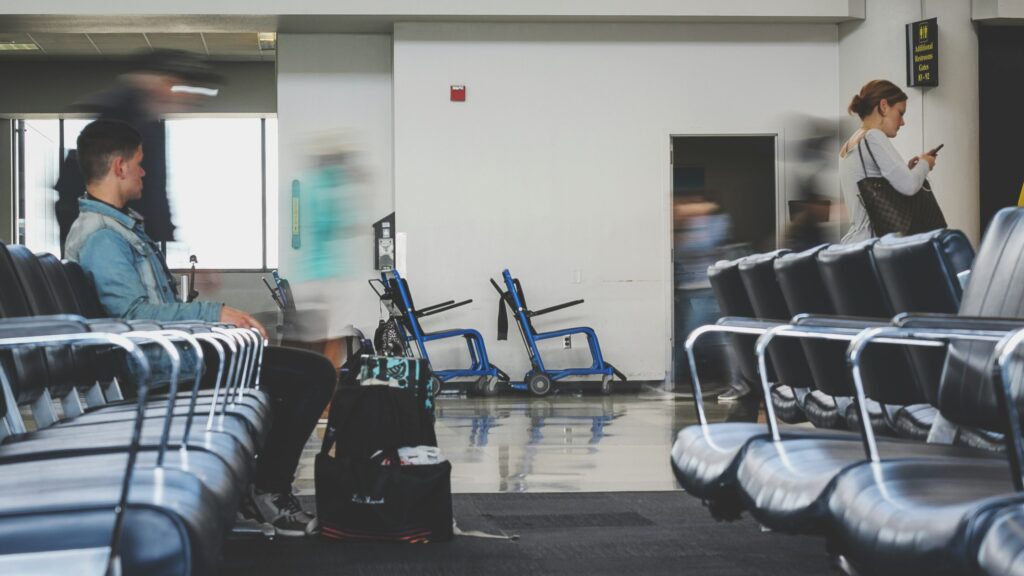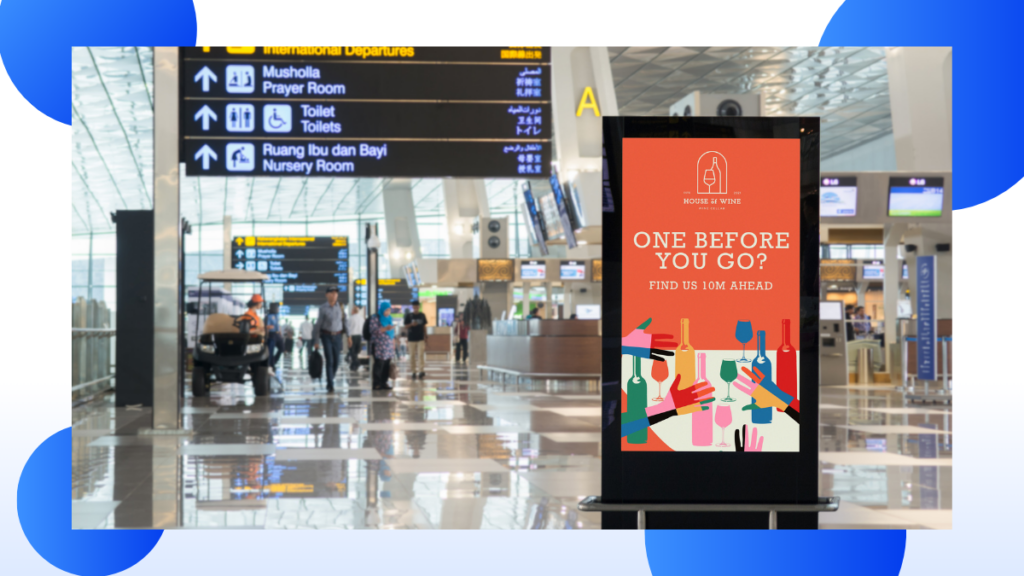Few places are as chaotic and anxiety-inducing as airports. However, digital wayfinding is a smart, modern solution to drastically improve airport processes. Digital Signage wayfinding in airports contributes to reducing congestion, boosting revenue, and easing the airport anxiety we all know so well.
Whilst digital wayfinding doesn’t solve every issue airports face, it significantly improves the easily fixable communication issues. When static signs, help desks, and printed maps fail, digital signs bridge the gap between passengers and the airport.
What Is the Function of Wayfinding?
Wayfinding helps us get from point A to B. In your everyday life, you will see some form of digital wayfinding. Whether at an airport, restaurant or conference, wayfinding will streamline your experience by funnelling customers and guests from the start point to the chosen destination.
What is Airport Wayfinding?
Airport wayfinding helps you to easily navigate the confusing world of airports. Before digital signage, airport wayfinding was much less sophisticated. Previously, passengers would’ve had to rely on static signs with non up-to-date information, or congested help desks to find the necessary information.
Digital wayfinding is a modern solution to route planning. It utilises digital signage software to display area-specific maps, automatic updates and interactive elements on high-definition digital screens.
You have probably already seen a variety of digital signage systems. Dynamic billboards at sports arenas, menu screens at your favourite fast food restaurant, and interactive maps at your local shopping centre all use this technology to communicate with customers, visitors, and employees.
Airport Anxiety
In 2019, airport lounge access company Priority Pass surveyed 1,000 British passengers about airport-related stress.
- Over 50% of passengers are worried about missing boarding
- Passengers found these four stages of travelling through an airport the most stressful: checking in, passing through security, baggage collection, and transfers
Whilst there are many factors out of our control in airports, airport digital signage can be used to make improvements. From providing information to find where you need to go, to live updates on your flight, wayfinding digital signage gives airports the chance to take control and stay organised.

What Are the Challenges of Wayfinding in the Airport?
With thousands of people in airports every day, it can be a difficult and time-consuming task to keep everyone safe, whilst ensuring a diverse range of cultures and beliefs are catered for.
That’s not the only challenging aspect of airport wayfinding.
- Congestion. Congestion can pose a health and safety risk, so it’s important for airports to be as organised and streamlined as possible.
- Floor plans. To avoid confusion, floor plans and interior designs need to be intuitive and easy to understand.
- Inclusiveness. Airports have to consider the needs of disabled passengers, including sight-impaired individuals who struggle to read signs. Signs should be accessible to those who may be hearing impaired and available in a variety of languages.
What Are Some Examples of Airport Wayfinding Signs?
Video Walls for Real-Time Flight Updates
Video walls are large screens made up of smaller screens. Typically, these screens display comprehensive information about your flight and gate status. Airports can link automated gate information to their digital signs for seamless, real-time information sharing.
This type of airport wayfinding digital signage is very versatile. Install the screens at the entrance of an airport terminal to showcase all the entertainment facilities, or place them in a lounge to advertise in-flight refreshments.
Interactive Freestanding Kiosks for Directions & Feedback
Freestanding kiosks are great alternatives to help desks. Whilst nothing will take the place of help from a friendly face, interactive kiosks take up less space, cost less in the long term, and make information sharing easier than ever before.
Interactive maps allow your guests to see where they are in relation to terminals, transport drop-off and pick-up points, toilets, entrances, entertainment facilities, restaurants, and more. When time is of the essence, digital maps make all the difference. This type of admin support also allows airport employees to focus on other customer-facing activities.
Interactive kiosks are also great for data harvesting. You can upload simple questionnaires, feedback forms, or even just prompts with emojis to gauge reactions to your latest marketing efforts.
High-Brightness Screens to Reinforce Regulations
The versatility of digital wayfinding tools allows airports to run more efficiently and safely. Whilst being excellent for directions, the high-brightness displays also offer an excellent way to reinforce rules and keep passengers and employees safe. High-brightness displays offer a great way to reinforce rules and keep passengers and employees safe.
Here are the most common regulatory signs in airports:
- Emergency evacuation procedures
- Details about the liquid hand luggage allowance
- Information about security checks
Security checks can be overwhelming and stressful for passengers, with different airports having different rules. Digital signage means you can upload clear, concise instructions to keep passengers informed and reduce congestion.
Advertisements for Duty-Free Products & Restaurants
In a study by MIT, the human brain can process an image in just 13 milliseconds. Researchers also found that 90% of the information transmitted to the brain is visual. Strategically placed kiosks, high-brightness screens, and LED displays can tap into the visual nature of the brain, even on a subconscious level.
According to a YouGov poll of British passengers, there’s a lot of money to be made inside airports.
- 47% connect to airport WiFi
- 44% shop at Duty Free
- 42% eat at airport restaurants
When your airport wayfinding signs aren’t showing directions or safety information, you can display marketing content for restaurants and Duty-Free products. Digital screens are so versatile that you can display urgent flight information and switch to revenue-boosting content within seconds.
Benefits of Digital Airport Wayfinding
The benefits of airport wayfinding digital signage are broad and varied.
- Cohesive branding. Display cohesive branding on all your digital screens to boost brand recognition.
- Emergency tool. If emergency situations occur, you need to act fast. Upload step-by-step evacuation information, warnings, and information about safety hazards.
- Enhance the passengers’ experience. Digital Q&A boards, interactive maps, and even just static boards with directions can alleviate travel anxiety.
- Good investment. The most expensive part of investing in modern wayfinding is digital signage software, but once your system is in place, your only expenses are electricity and content creation.
- Reduces administration costs. Q&A kiosks can answer the same questions as a help desk assistant. Upload standardised responses to reduce confusion, increase trust, and help your passengers stay on track.
- Simple operating system. Our digital signage hardware is a simple solution for large-scale companies.
- Streamline trips through the airport. Interactive maps are a staple in airport wayfinding, and for good reason. They reduce stress, support customers who are late, and reduce congestion.
Contact TrouDigital for Airport Wayfinding Digital Signage
Looking for effective, comprehensive digital signage for airports? Think TrouDigital. TrouDigital has worked with recognised brands such as Porsche, Asos, and Morrisons to provide full-scale digital signage support.
When you choose TrouDigital, you can leverage years of insight to create effective digital wayfinding systems that meet your unique needs.
Read TrouDigital’s success stories here.
